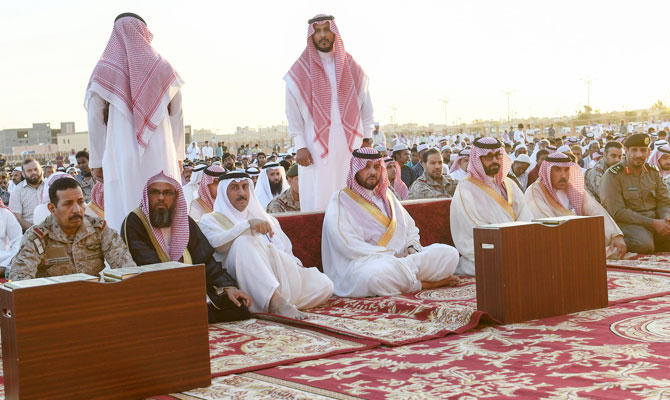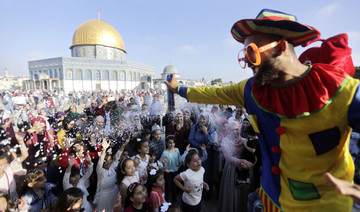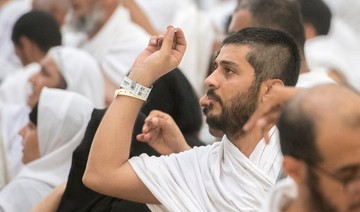JEDDAH: Muslims celebrate their second beloved Eid, the Eid Al-Adha, the second Eid of the year after the Eid Al-Fitr.
It is the biggest festival of the year, to commemorate the valor, bravery and faithfulness of Prophet Ibrahim (peace be upon him) and his son Ismail (peace be upon him). Prophet Ismail was brave and young and willingly offered himself for sacrifice, when his father was asked to sacrifice his most beloved possession.
Moments before Ibrahim was about to sacrifice his beloved son, Allah sent a ram to take Ismail’s place, and now millions of Muslims celebrate this day by sacrificing animals and dividing them into three parts. One third is distributed among the poor, one third among relatives and the last third is kept for the family.
This Eid is a source of immense joy to Muslims as they decorate their houses, wear new clothes and give as much as they can to the poor. It focuses on food more than any other events. After the obvious distribution, giving to the poor and worshipping, people tend to hold dinners with the main dishes made with meat, or hold barbecues, to celebrate with friends and families.
In many different countries, people have different traditions they follow: In China, families go to their ancestors’ graves and pray for their forgiveness in front of Allah. In the West, gifts are given to children, and in the Middle East youngsters are given money called “Eidi” or “Eidiya.”
Children are the most excited about this event as they get to enjoy their favorite food and receive money and gifts from elders.
Ghala Al-Otaibi, a Saudi citizen of Taif, said: “We celebrate Eid with relatives living at a distance and parents; there is usually a variety of food.”
Mohammad Al-Harthy, also from Taif, said: “We visit our families and enjoy a lot, we usually slaughter a sheep or a camel. Most of the people celebrate Eid in the same way, but the only difference may be in food traditions.”
Amna Abbasi, a Pakistani mother from Jubail, said: “During Eid, adults and children wear new clothes and exchange gifts with each other. Children love to participate in this process as they learn the value of giving to others and cherishing the smiles of the needy.”
Saudis, expats share Eid experience in the Kingdom
Saudis, expats share Eid experience in the Kingdom

- This Eid is a source of immense joy to Muslims as they decorate their houses, wear new clothes and give as much as they can to the poor
First phase of 2024 Hajj security plans completed

MAKKAH: Col. Talal bin Abdulmohsen Al-Shalhoub, security spokesperson at the Ministry of Interior, announced during a daily press conference for the 2024 Hajj season the successful completion of the first phase of security plans to lead pilgrims from Makkah to subsequent holy sites.
After spending around 12 hours in Arafat on Saturday for the most important part of Hajj, the over 1.8 million worshippers officially moved to the rocky plains of Muzdalifah in preparation for the final stages of their Hajj.
“The second stage of the journey to the holy sites is currently being implemented to transport pilgrims from Arafat to Muzdalifah, where they will be spending the night before departing to Mina for Eid Al-Adha,” said Al-Shalhoub.
He added that 25 persons found to be violating Hajj regulations were arrested on the night of June 15 for transporting 103 individuals without Hajj permits.
“The Unified Security Operations Centers (911) in Makkah received 52,274 calls from June 14 to 15. These calls varied between security reports, inquiries, and service calls from pilgrims,” he said.
Speaking on the journey to Muzdalifah, Ayed Al-Ghuwaynem, undersecretary of the Ministry of Hajj and Umrah for Hajj Affairs said: “The tranquility and comfort we witnessed today in Arafat enabled the pilgrims to perform rituals and devote themselves to worship and supplication.”
He added that the smooth operations were the fruit of early planning and collective governmental action.
“This was the result of distinguished cooperation from pilgrims’ affairs offices from all countries, as well as pilgrims’ service providers inside and outside the Kingdom,” said Al-Ghuwaynem.
Dr. Mohammed Al-Abdulali, spokesperson for the Ministry of Health, said that over 112,000 pilgrims have received health care from different providers during the Hajj season, including clinics, emergency departments, hospitals, and intensive care units.
Mashaer metro system transports thousands of pilgrims from Mina to Arafat

- There are 17 trains in the Mashaer metro fleet, each capable of carrying 3,000 passengers
MAKKAH: Hundreds of thousands of pilgrims used the Mashaer metro system to travel from Mina to Arafat on Saturday, as they began the most important day of the Hajj pilgrimage.
The metro system consists of nine stations located across the holy sites, connected by an 18-kilometer double-track railway, and is capable of accommodating 72,000 passengers per hour in one direction. The journey from Mina to Arafat takes just 20 minutes, with the train traveling at 80 km per hour, according to a report by the Saudi Press Agency.
There are 17 trains in the Mashaer metro fleet, each capable of carrying 3,000 passengers. The eco-friendly electric trains significantly reduce traffic congestion and carbon emissions by replacing approximately 50,000 passenger buses during the Hajj season.
The trains are managed the Facilities Security Forces, under the supervision of the Ministry of Interior.
Khalil Hasan, an Egyptian pilgrim, said he is performing Hajj for the second time.
“The first time I performed Hajj was nearly 30 years back when I was a schoolteacher in Yanbu. Everything here has unbelievably changed, including the Jamarat Bridge.“Seeing the metro travelling between stations in the holy sites was a wonderful scene that added great glamor to the place and substantial enhancement to the many services provided by the kingdom,” Hasan said.
Previously, he added, he could not have imagined that a pilgrim would be able to reach Arafat from Mina within minutes.
Hasan’s lifelong friend, AbdulTawab, who is accompanying him on the spiritual journey, said that it is his first Hajj experience, and he was amazed by the metro service.
“It is wonderful, and I am grateful to the Kingdom for this metro that has facilitated the movement of pilgrims, especially the elderly, making it easy and comfortable to move from one place to another within the holy places,” he said.
Pilgrims prepare for the final stages of Hajj

- Pilgrims spent the night in Muzdalifah, under the open sky, where they took the time to rest and refresh
MAKKAH: Hajj pilgrims have begun preparing for the final stages of this year’s pilgrimage, arriving in Muzdalifah after spending the entire day performing prayers and supplications in Arafat.
After they arrived in Muzdalifah, pilgrims performed Maghrib and Isha prayers and collected pebbles for the stoning rituals at the Jamarat area in Mina, which begin Sunday morning.
These stones are used once they reach Mina, where pilgrims perform the “first throwing” of Jamarat, before heading to the Grand Mosque in Makkah for tawaf (circumambulation) and “sacrificing the lamb,” a commemoration of the sacrifice Prophet Ibrahim had intended to make of his son Ismail as an act of obedience to Allah.
Pilgrims spent the night in Muzdalifah, under the open sky, where they took the time to rest and refresh.
The first day in Mina, the 10th of Dhul Hijjah, marks the first day of Eid Al-Adha. On this day, pilgrims sacrifice animals. Male pilgrims have their heads shaved and take off their ihram clothes. Female pilgrims cut only a portion of their hair.
Hisham Thamin, an Indian pilgrim living in Qatar, told Arab News that it had been a seamless Hajj experience.
“It’s a very nice (and) very spiritual feeling. I’m enjoying the vibes here. The people here are very calm. It’s a very peaceful atmosphere.”
Thamin said that he was initially concerned about the arrangements given the heat and high numbers of people, but he was pleasantly surprised by the coordination and organization by the Saudi government.
“I’m glad the Saudi government has made very good arrangements. There’s cold water, cold juices, and breakfast boxes for everyone. They have spread out all the sheets on the sand, to make sure it’s comfortable for everyone. So I’m liking it very much. And it’s not what I expected, it’s much better than what I expected.”
Nawaf Alhabib, a Saudi pilgrim, said his experience had been “perfect.”
Alhabib planned to walk to Mina on Sunday morning before Fajr prayer.
“By 12 in the morning, we will finish from Muzdalifah and make our way towards Mina. We will rest and then perform Jamarat and it will hopefully be a beautiful day tomorrow.”
Saudi pilgrim Tawfeeq Alquraishi said he was proud of the developments and initiatives fulfilled by the Kingdom.
“The services provided to ensure a smooth Hajj experience for pilgrims is something I am so proud of as a Saudi national. This is a successful and comfortable Hajj.”
Waleed Mohammed, a pilgrim from Egypt, was grateful for being able to perform Hajj.
“This is a feeling I cannot explain. Thank God for everything,” he said. “This is an experience that everyone dreams of … everyone is happy and the organization is beyond our expectations.”
225 pilgrims treated for heat stress and fatigue on second day of Hajj

- The cases were treated at the Medical Center for Heat Exhaustion and Sunstroke
MAKKAH: About 225 cases of pilgrims suffering from heat stress and fatigue had been treated at the medical center for heat exhaustion and sunstroke in Makkah, the Saudi Press Agency reported on Sunday.
The cases were reported on Saturday, the second day of Hajj, when pilgrims ascended Mount Arafat to ask God for mercy, blessings, prosperity and good health.
The ritual at Mount Arafat, known as the Hill of Mercy, is considered the peak of the Hajj pilgrimage.

The center, affiliated with the Saudi Ministry of National Guard Health Affairs, has 20 beds equipped with the latest equipment to deal with cases of heat stress and sunstroke.
It is also equipped with an air and water spray system using sprinklers to cover all parts of the injured person’s body, in addition to clinics for men and women and a pharmacy.
Saudi officials had earlier advised pilgrims to use umbrellas and keep themselves hydrated, and to take rest periods between rituals to avoid heat fatigue.
The National Center for Meteorology had forecast that temperatures in Makkah would range between 45 C and 48 C, with little rain potential.
Arafat sermon projected to reach 1 billion listeners worldwide

- The translated sermons promote peace, coexistence and a deeper understanding of Islam
ARAFAT: The Arafat sermon delivered on Saturday at Namira Mosque in Makkah was projected to reach a staggering 1 billion listeners around the world, the Saudi Press Agency reported.
The sermon was translated live into 20 languages as part of the groundbreaking initiative launched by Saudi Arabia’s King Salman in 2018. There were also non-simultaneous translations into 17 other languages.
Led by the Presidency of Religious Affairs of the Two Holy Mosques, the project serves as a cornerstone in spreading the message of moderation and centrism espoused by the holy sites, SPA said.
“The translated sermons promote peace, coexistence, and a deeper understanding of Islam — a religion built on mercy, tolerance, and peaceful living,” the report said.
When the project was launched in 2018, translations were offered in only five languages. Its reach has continued to grow each year. Sermons are translated into an increasing number of languages and broadcast on various platforms, including digital platforms, FM radio, and Islamic television channels.
“These efforts demonstrate the Kingdom’s unwavering commitment to serving Islam and the global Muslim community,” the report said, adding that the initiative “exemplifies Saudi Arabia’s dedication to serving the Two Holy Mosques and their pilgrims. It further reflects the leadership’s commitment to promoting global peace and the values of tolerance and moderation.”
The report continued: “Having surpassed 200 million listeners in 2020, the project fulfills the Kingdom’s sacred responsibility of caring for the Two Holy Mosques and their visitors. By translating the Arafat sermon, they effectively share the message of these holy sites with the entire Muslim world.”






















